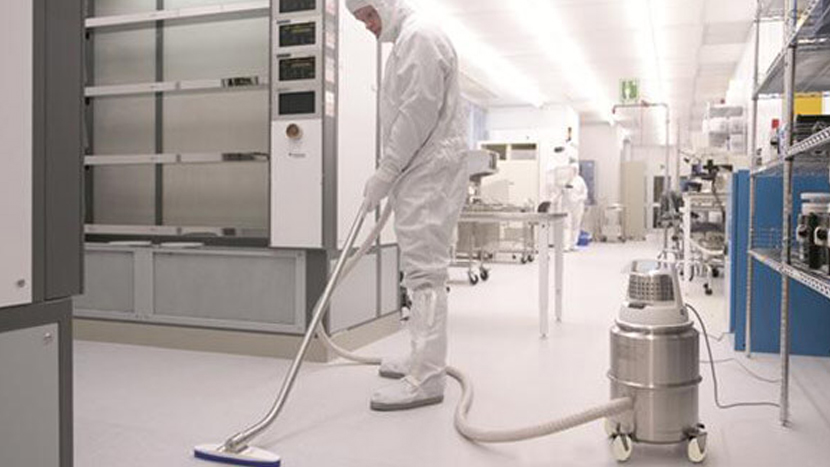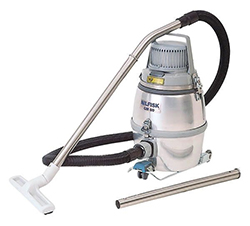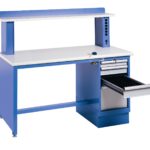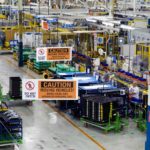This article is also available in Spanish.
“Do more with less.” It’s the new mantra in today’s economy. Companies across many industries face the challenge of “right-sizing” – fine-tuning operations to wring the most efficiency from limited resources.
Pharmaceutical manufacturing is no exception, and if you’re feeling the squeeze, you’re are not alone. According to a new report by Roland Berger Strategy Consultants, increasing price and cost pressure, regulatory changes, and expiring patents are leading to shrinking margins in the pharmaceutical industry.
Unfortunately, shrinking margins do not translate into fewer contamination control responsibilities. In fact, if your facility is like countless others across the country, you are faces with cleaning challenges that are more serious and more complicated than ever before – all while having to ensure compliance with government regulations as well as customer and insurance audits.
The responsibility to protect your people, your products and your operation is yours. The right partner can help you make the safe choice for industrial cleaning equipment. This guide includes the top questions a trusted vacuum supplier will ask to assess your specific application and facility needs. It is designed as a resource to help jump-start your search for the right partner and the right industrial vacuum cleaner to get the job done.
Does your facility require a dust collector or an industrial vacuum cleaner?
The two terms are often used interchangeably, but dust collectors and vacuums are very different machines. A dust collector has high air flow (cfm) but low waterlift, or suction. It can effectively collect airborne dust but cannot pick up dust from the floor.
An industrial vacuum cleaner has a better balance of airflow and waterlift to provide the performance required to collect debris, dust, etc. from floors, machinery, overhead beams and walls.
What type of vacuum cleaner will meet your cleaning needs?
There are certain vacuum cleaners that are not appropriate for use in pharmaceutical or nutraceutical environments – like shop-style vacuums, for instance. These vacuums simply aren’t built to handle the rigorous cleaning demands of the pharmaceutical industry. They don’t have high-quality filtration, and they are made of materials that are difficult to sanitize.
Instead, focus on high-performance industrial vacuums that are designed for use in a pharmaceutical environment. If the vacuum is to be used in a cleanroom environment, it must meet demanding standards set by the International Organization for Standardization (ISO). ISO 14644-1 sets guidelines for air cleanliness determined by the permissible particle size and levels of concentration allowed. Compliance with this standard requires a designated cleanroom vacuum with a HEPA and/or ULPA filter.
Consider selecting different vacuums for different purposes – cleaning tasks – within a facility. Don’t stretch one model too thin; it might be best for thorough cleaning around production lines but not built for handling liquids. Work to identify all of your cleaning needs and then select appropriate vacuums for different cleaning scenarios.
How often will the vacuum cleaner be in operation?
The duration of usage will help you begin to choose the right vacuum. Tableting suites or cleanrooms on a scheduled cleaning regimen will benefit from using a single-phase vacuum cleaner. Single-phase machines are well suited for general cleaning of the suite and around the production equipment. You can also connect a single-phase vacuum directly to production equipment (such as tablet processing lines) if that equipment will not be run continuously. Connecting your vacuum directly to production line equipment minimizes the spread of fine dust and keeps all waste materials away from workers.
For continuous use or 24/7 operations, use a three-phase vacuum as it’s the most economical configuration. Compared to a single-phase motor, a three-phase will operate with a higher efficiency over longer durations. In essence, a three-phase vacuum is a prime example of right-sizing, doing more with less.
If you plan on integrating your vacuum with processing equipment, learn as much as you can about that machine. Look for specifications such as the number of ports per machine and the airflow per port and provide this information to your vacuum supplier. Armed with this information, they can make a more informed recommendation about the best vacuum for your needs.
What type of electrical service is available at your facility?
Electric industrial vacuum cleaners have a variety of different voltage or amperage requirements dependent upon the size and type of motors that power them, which is generally dictated by the application requirement or cleaning tasks at hand. While some smaller machines can operate on common single-phase, 15- or 20-amp, 120-volt electrical service, other vacuums require three-phase power. It is important to determine the application needs where the vacuum will be operating, so the machine can be properly matched to the type of service available, or the service matched to the demands of the machine that provides the best solution.
Is your dust combustible? Is it rated?
The National Fire Protection Association (NFPA) defines combustible dust as any finely divided solid material that is 420 microns or smaller in diameter and presents a fire or explosion hazard when dispersed and ignited in air. In tis Combustible Dust National Emphasis Program (NEP), OSHA defines combustible dust as a “particulate solid that presents a fire or deflagration hazard with suspended in air or some other oxidizing medium over a range of concentrations, regardless of particle size or shape.”
While active pharmaceutical ingredients and excipient ingredients can cause combustible dust, production lines of oral solid dosage, including tablets, are most at risk from such dust. Most pharmaceutical ingredients are powders and consequently prone to becoming dangerous airborne dust.
The National Electric Code (NEC) provides guidance on special requirements for electrical equipment, depending on the hazard. It classifies locations by type, conditions and nature. Private laboratories or OSHA can test and rate material for combustibility and classification. The authority having jurisdiction (AHJ) will make the final decision as to whether the dust is combustible and whether it requires “explosion-proof/dust ignition-proof” vacuum. Not all facilities handling combustible dust need an explosion-proof vacuum.
What type of filtration is necessary to meet your cleaning needs?
Consider the particle size of the material to be collected. In a pharmaceutical manufacturing environment, a vacuum equipped with a HEPA filter is critical – or an ULPA filter may be required, depending on your dust and environment. HEPA filters retain 99.97% of all particles down to and including 0.3 microns. ULPA filters retain 99.999% of all particles down to and including 0.12 microns.
Be sure to select a vacuum with a true HEPA filter – one that is engineered into the product, not retrofitted as an add-on. In addition, select a HEPA vacuum that meets IEST (Institute of Environmental Science and Technology) Standards and Recommended Practices (RPs) for cleanrooms and controlled environments.
For peak operating efficiency, a vacuum should have a multi-stage, graduated filtration system that uses a series of progressively finer filters to trap and retain particles as they move through the vacuum. This multi-stage design protects the main filters from blocking up quickly and minimizes motor wear and tear over time.
Ideally, a vacuum filtration system should use oversized main filters with plenty of surface area. Larger surface areas optimize the air-to-cloth ratio, slowing the airflow across the filter and enabling the vacuum to easily collect large volumes of material over extended periods of time, while minimizing clogging. This helps reduce vacuum downtime and maintenance.
For cleanroom applications, the filter location within the vacuum is also critical. As mentioned above, ISO standards for pharmaceutical manufacturing are very stringent; therefore, cleanroom vacuums with single phase universal motors should have carbon filters installed upstream and downstream to capture particulate from its airflow and exhaust stream. An “upstream” filter – placed before the motor – protects the motor and extends the life of the vacuum, while a “downstream” filter – placed after the motor – captures the dust created by the motor’s commutator and carbon brushes to keep it from being released back into the environment through the exhaust stream. Downstream filters also help safeguard employees during motor maintenance. With the proper filtration, fresh clean air should always be exhausted from the back of the vacuum, regardless of what goes into the hose.
How much material will be collected at any given time?
Answering this question is harder than it seems, because different types of collected material occupy very different amounts of space. It is, therefore, easy to overestimate or underestimate your needs. If your primary task is collecting fine powders, you may not need as much collection capacity as you think. Once collected, powders do not occupy a large amount of space in a collection tank.
Ultimately, the only way to truly get an accurate assessment of your needs is to work with a vacuum manufacturer or distributor who can arrange for a demonstration at your facility. That way, you can try different vacuums and collection configurations in the real-life scenarios your crews face every day.
What collection options will meet your cleaning needs?
Corrosion-resistant stainless steel vacuums are ideal for the pharmaceutical industry because they make decontamination and sanitization easier as they can be quickly cleaned with little to no trace of waste residue. There are several options for collection containers to be used with these vacuums.
Standard paper bags capture large amounts of non-hazardous material. They feature a two-ply construction with an inner lining that captures fine particles while air passes through the outer cellulose layer. Paper bags capture the bulk of large particles for easy collection and disposal.
Polyliners are a great way to dispose of nuisance material – and even hazardous material – while preventing a dust plume. By lifting out the entire liner, you can remove large amounts of dust and debris quickly and easily. Conductive polyliners help keep he vacuum grounded and are available for the safe collection of combustible dust.
A fourth – perhaps critical option – is the Safe-Pak™ safe-change system for secure hazardous material removal. This method is perfect for managing potent compounds in the pharmaceutical industry. When incorporated with certain industrial vacuums, the Safe-Pak™ system collects particles and retains them in a disposable HEPA-filtered container. This protects the machine and the production environment from contamination and provides a safe and easy means of disposing of the collected waste. The HEPA filter inside the Safe-Pak™ system meets IEST Standards and Recommended Practices.
Will you need to collect controlled substances?
If you are working with potentially hazardous materials or controlled substances – or if you are doing pilot testing for new pharmaceuticals that may be controlled substances – you need a collection method that will help you account for every gram of product. The best way to collect the material is with either a polyliner, for effective containment, of better yet, a Safe-Pak™. The HEPA filters within the Safe-Pak™ containers are numbered for traceability and accountability.
Will you use the vacuum cleaner in temperature-controlled environments?
Industrial vacuums can generate a fair amount of heat and exhaust. So when you use these machines in temperature-controlled environments – like some tableting suites – you need to take this extra heat source into consideration. Your air conditioning systems may be capable of handling the extra heat and still maintaining the required temperatures in the suite. However, if the air conditioning system can’t safely handle the job, then the vacuum exhaust can be ducted directly from the vacuum and out of the suite altogether. Ask your vacuum provider for more details on the accessories you’ll need.
Will the vacuum need to collect liquid?
It is a good idea to keep at least one wet/dry vacuum at your facility. Even if you may only need to collect small amounts of liquids from time to time, you need to use a wet/dry vacuum for the job. A wet/dry vacuum has a grounded bypass motor to avoid electrical hazards.
Dry only vacuums are not equipped with features that enable the collection of liquids. Attempting to collect liquid with a dry-only vacuum can ruin the machine and cause serious injury. For best results and a longer, more efficient vacuum life, choose a wet/dry vacuum with a stainless steel or polyethylene tank to prevent corrosion and an automatic shut-off valve to prevent overfilling.
What types of hoses and accessories will meet your cleaning needs?
One of the benefits of working with a reputable manufacturer that produces top-quality industrial vacuums is that you should find a variety of accessories that have been engineered specifically for the pharmaceutical industry.
- Anti-static, FDA-approved, polymer-constructed clear hoses
- Cleanroom-compatible wands, dust brushes and crevice nozzles
- Autoclavable accessories made of stainless steel or high-resistance silicone for sterilization
- Overhead cleaning tools for pipes, beams, and other hard-to-reach areas
What else can I do to be sure I choose the right vacuum?
After gathering the answers to the questions above, the next critical step is to arrange for an on-site demonstration. Don’t underestimate the value of a live demonstration at your facility where you can take advantage of expert consultation.
A demonstration and hands-on experience with a prospective vacuum serves two purposes. First, the management, purchasing and housekeeping teams can all witness the vacuum in operation in the environment where it will be used and evaluate its quality. Second, it gives you the chance to ask questions and try multiple models – with the help of a technical sales representative – so you can quickly assess which model (or models) will best meet your plant requirements.
Training and Maintenance
Once you have selected the right vacuum, operator training is essential to the success of your new housekeeping plan. For best results, select a manufacturer or vendor that provides training after the sale. Training should cover areas to be cleaned and cleaning methods. Complete training will explain vacuum types, vacuum technology, features, operating procedures, maintenance and storage.
Training does not stop at vacuum delivery. It is good practice to follow initial training with periodic reviews to refresh and update operators’ cleaning knowledge. By doing so, facility management will maximize industrial vacuum performance and extend unit operating life.
Need-to-Know Criteria
What do I need to know about filtration?
As mentioned earlier in this guide, high-performance industrial vacuums feature multi-stage, graduated filtration systems that use a series of progressively finer filters to trap and retain particles as they move through the vacuum.
This multi-stage system protects filters from blockage and excessive wear and tear. The first stage of filtration – the paper bag – captures most of the larger particles while the main filter captures residual particles before they pass through the motor. Finally, the last stage with the HEPA filter collects the fine particles in the exhaust before they become airborne. The vacuum filtration system is the main protection for the motor, and filter maintenance is the key to maintaining long life and high operational efficiency for your vacuum.
To ensure that airflow does not become diminished, the main filter should be cleaned on a regular basis. Frequency of filter cleaning is dictated by several factors – mainly the material being collected and the time the vacuum is in use. Higher-end industrial vacuums will have internal shaker handles and other advanced internal methods such as automatic reverse purge systems that enable the operator to agitate (and thereby clean) the filter without shutting down the vacuum. When the filter is agitated, the dust and debris fall into the lower collection chamber.
Eventually, despite proper maintenance and cleaning, enough particles will become embedded in the main filter to impede proper airflow. When this happens, the filter must be replaced. The timing of filter replacement depends on many variables including the material being collected, how often the vacuum is used and how well the filter was maintained.
Larger industrial vacuum models often feature manometers to indicate when airflow is good (filter is clean) and when it is impeded (filter is clogged). Careful attention to the manometer enables an operator to perform filter shake-outs at the right time to maintain top performance.
Does the HEPA filter need to be cleaned, too?
HEPA filters are not designed to be agitated or cleaned like a main filter. However, proper main filter maintenance will extend the life of the HEPA filter as well. Timely replacement of the downstream HEPA or ULPA filters also helps maintain the purity of your vacuum cleaners’ exhaust and the integrity of your cleanrooms. Typically, HEPA filters last twice as long as a main filter and should be replaced every other time you replace your main filter.
How do I maintain the anti-static nature of the vacuum?
All parts and accessories, from the tip of the hose to the main housing, should be anti-static and fully compatible with the vacuum. Any regular or “static” parts added to the vacuum negate the anti-static nature of the entire machine. That means no tape and no shop-style or other standard hoses. Maintaining the anti-static nature of the vacuum is extremely important not only for employee comfort and safety, but because it minimizes the risk of igniting dust from fine powders.
Resources
- OSHA: Combustible Dust National Emphasis Program
- OSHA: Safety and Health Information Bulletin (SHIB) (07-31-2005) Combustible Dust in Industry: Preventing and Mitigating the Effects of Fires and Explosions
- FDA: www.fda.gov
- Institute of Environmental Sciences and Technology: www.iest.org
- Internal Organization for Standardization: www.iso.org
Reprinted with permission from Nilfisk, Inc.
Nilfisk manufactures industrial vacuums to deliver a high standard of hygiene, avoid cross contamination and increase production efficiency in cleanrooms and controlled environments. They engineered the first cleanroom-packaged vacuums, and originally developed vacuums with HEPA and ULPA filtration. Nilfisk vacuums are approved for cleanrooms up to ISO Class 4 (Fed. Class 10).
Production Automation Corporation is an authorized Nilfisk distributor. When purchasing vacuums for cleanrooms and other critical environments, lean on our specialists for end-to-end service and purchase support for the pharmaceutical, semiconductor, and general cleanroom manufacturing industries.
Related Posts
- Lean Cellular Manufacturing: Processing, Methods, Layouts, and Implementation
Cellular manufacturing helps reduce waste by reducing defects that result from processing and product changeovers. Since products or components move through a cell one piece at a time, operators can quickly identify and address defects.…
-
Cleanroom HEPA Vacuum Use and Applications
Cleanroom HEPA Vacuum Components and Applications Simply put, every square inch of a cleanroom should be absolutely pristine. Ceiling panels, lighting units, HEPA filtration units, sprinkler heads, walls, glass surfaces, process equipment, piping systems, floors,…
-
Selecting the Best Workbench for Manufacturing, Electronics, Packaging, Or Assembly
This step-by-step guide will help you choose the right industrial workbench for all your needs. The best workbench buyers guide for information on best sizes, lighting, accessories and applications.
-
Mobile Hand Washing Stations and Sinks for Manufacturing
Portable hand sinks have internal water supply and waste water storage. The standalone unit with powered pump supply requires no additional plumbing, drains, or inlets.
-
New Accuform Manufacturing Signage
Are you in compliance? Do you qualify for an exemption? Generic signage no longer adheres to recent Proposition 65 updates. Custom order Accuform signage is now available from PAC. Our specialists tailor hazard signage for…
-
GMP Cleanroom Design Standards Part 1: GMP and CGMP Manufacturing
What is GMP? What is CGMP? What are the differences between GMP and CGMP cleanrooms?










